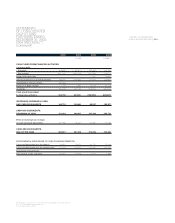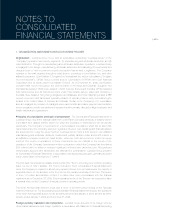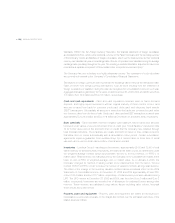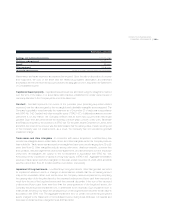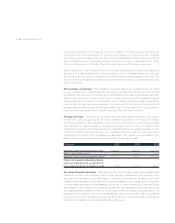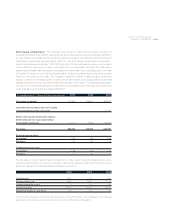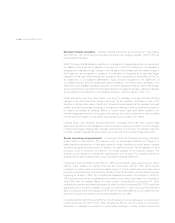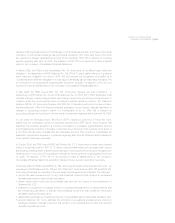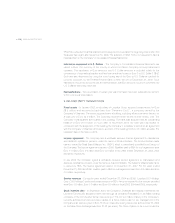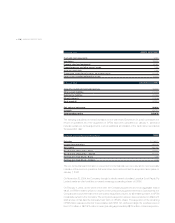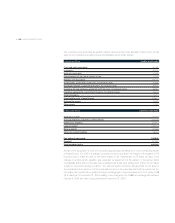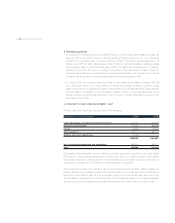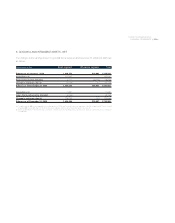LensCrafters 2005 Annual Report Download - page 116
Download and view the complete annual report
Please find page 116 of the 2005 LensCrafters annual report below. You can navigate through the pages in the report by either clicking on the pages listed below, or by using the keyword search tool below to find specific information within the annual report.NOTES TO CONSOLIDATED
FINANCIAL STATEMENTS | 115 <
replaces it with a general exception for exchanges of nonmonetary assets that do not have commercial
substance. A nonmonetary exchange has commercial substance if the future cash flows of the entity
are expected to change significantly as a result of the exchange. SFAS 153 is effective for reporting
periods beginning after June 15, 2005. The adoption of SFAS 153 is not expected to have a material
effect on the Company’s Consolidated Financial Statements.
In March 2005, the FASB issued Interpretation No. 47, Accounting for conditional asset retirement
obligations - an interpretation of FASB Statement No. 143 (“FIN 47”), which clarifies the term “conditional
asset retirement obligation” as used in SFAS 143 and requires the recognition of a liability for a
“conditional asset retirement obligation” if the fair value of the liability can be reasonably estimated. FIN
47 is effective for reporting periods beginning after December 15, 2005. The adoption of FIN 47 is not
expected to have a material effect on the Company’s Consolidated Financial Statements.
In May 2005, the FASB issued SFAS No. 154, Accounting changes and error corrections - a
replacement of APB Opinion No. 20 and FASB Statement No. 3 (“SFAS 154”). SFAS 154 applies to all
voluntary changes in accounting principles and changes required by accounting pronouncements in
instances where the pronouncement does not include a specific transition provisions. This Statement
replaces APB No. 20, Accounting changes, and SFAS No. 3, Reporting accounting changes in interim
financial statements. SFAS 154 requires retroactive application to prior periods’ financial statements of
changes in accounting principles unless it is impracticable to do so. SFAS 154 is effective for
accounting changes and corrections of errors made in fiscal years beginning after December 15, 2005.
In June 2005, the Emerging Issues Task Force (“EITF”) reached a consensus on Issue No. 05-6,
Determining the amortization period for leasehold improvements (“EITF 05-6”), which requires that
leasehold improvements acquired in a business combination or purchased significantly after, and not
contemplated at the inception of the lease, be amortized over the lesser of the useful life of the asset or
a term that includes lease renewals that are reasonably assured. This consensus is applicable for
leasehold improvements acquired or purchased beginning after June 29, 2005 and will be followed in
future periods if and when necessary.
In October 2005, the FASB issued FASB Staff Position No. 13-1, Accounting for rental costs incurred
during a construction period (“FSP 13-1”), which concluded that rental costs associated with ground
and building operating leases that are incurred during the construction period should be recognized as
rental expense in such period. This guidance is effective for reporting periods beginning after December
15, 2005. The adoption of FSP 13-1 is not expected to have a material effect on the Company’s
Consolidated Financial Statements and will be followed in future periods if and when necessary.
In February 2006, the FASB issued SFAS No. 155, Accounting for certain hybrid financial instruments - an
amendment of FASB Statements No. 133 and 140 (“SFAS 155”), which amends SFAS 133, and SFAS 140,
Accounting for transfers and servicing of financial assets and extinguishments of liabilities. The statement:
• permits fair value remeasurement for any hybrid financial instrument that contains an embedded
derivative that otherwise would require bifurcation;
• clarifies which interest-only strips and principal-only strips are not subject to the requirements of
Statement No. 133;
• establishes a requirement to evaluate interests in securitized financial assets to identify interests that
are freestanding derivatives or that are hybrid financial instruments that contain an embedded
derivative requiring bifurcation; and
• clarifies that concentrations of credit risk in the form of subordination are not embedded derivatives; and
• amends Statement No. 140 to eliminate the prohibition on a qualifying special-purpose entity from
holding a derivative financial instrument that pertains to a beneficial interest other than another
derivative financial instrument.


